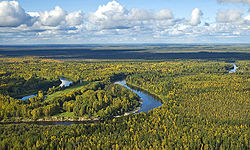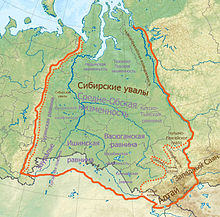
Back سهل سيبيريا الغربية Arabic Llanura de Siberia Occidental AST Qərbi Sibir düzənliyi Azerbaijani Көнбайыш Себер тигеҙлеге Bashkir Заходне-Сібірская раўніна Byelorussian Заходне-Сібірская раўніна BE-X-OLD Западносибирска равнина Bulgarian Sibèria Occidental Catalan West Siberian Plain CEB دەشتی سیبیریای ڕۆژاوا CKB
This article needs additional citations for verification. (July 2020) |
West Siberian Plain
Западно-Сибирская равнина | |
|---|---|
 View of the Vasyugan River | |
| Coordinates: 62°00′N 76°00′E / 62.000°N 76.000°E | |
| Location | Russia Kazakhstan |
| Part of | Siberia |
| Area | |
| • Total | 2,600,000 km2 (1,000,000 sq mi) |
| Dimensions | |
| • Length | 2,500 kilometers (1,600 mi) |
| • Width | 1,500 kilometers (930 mi) |


The West Siberian Plain (Russian: Западно-Сибирская равнина, romanized: Zapadno-Sibirskaya ravnina) is a large plain that occupies the western portion of Siberia, between the Ural Mountains in the west and the Yenisei River in the east, and the Altai Mountains on the southeast. Much of the plain is poorly drained and consists of some of the world's largest swamps and floodplains. Important cities include Chelyabinsk, Novosibirsk, Omsk, and Tomsk, as well as Surgut and Nizhnevartovsk.
Winters on the West Siberian Plain are harsh and long. The climate of most of the plain areas is either subarctic or continental. The plain had large petroleum and natural gas reserves. Most of Russia's oil and gas production was extracted from this area during the 1970s and 80s.[1]
